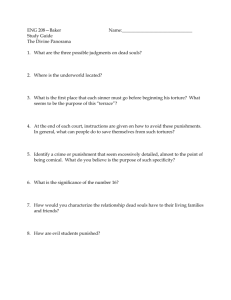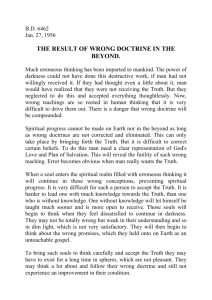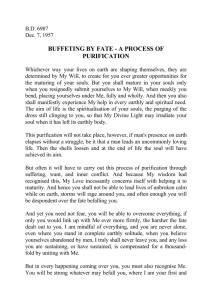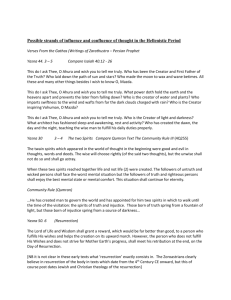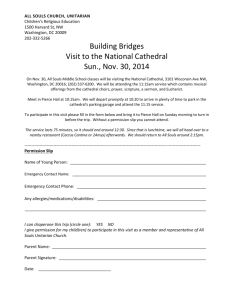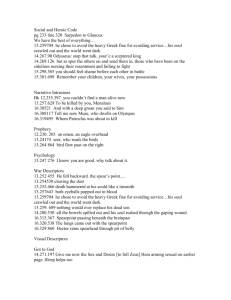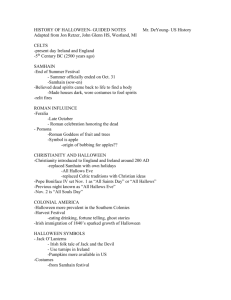Anth121Lec8SP14
advertisement
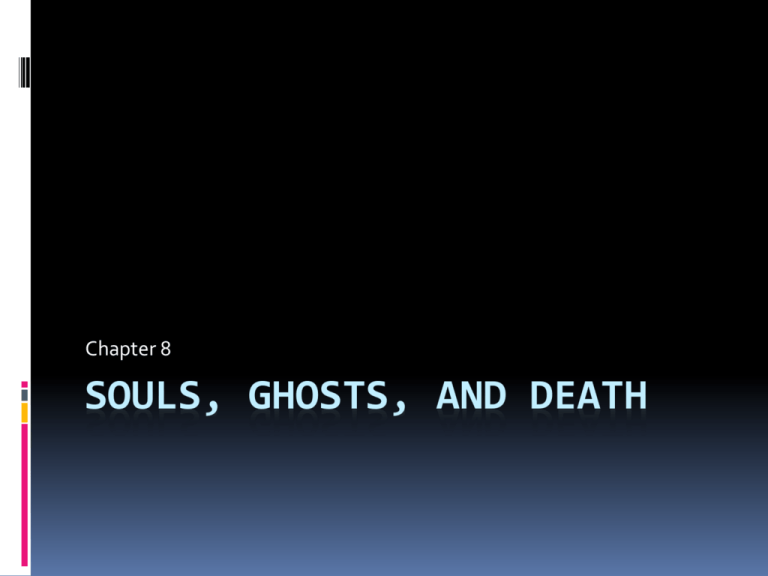
Chapter 8 SOULS, GHOSTS, AND DEATH Souls and Ancestors Soul is a spiritual part of a person and usually has an existence after death How many souls does a person have? Some believe that the soul can travel Shamans During dreams Souls There is a lot of variation on what this means The concept of a souls is found in all cultures Some believe in multiple souls Ex. The avenging soul (miusak) of the Jivaro led to the practice of headhunting and shrunken heads to keep this soul from revenge Souls and the Afterlife The idea of a soul is tied to death Souls may linger with family, go to an afterlife, or be reincarnated (into people) or transmigrated (into animals) The soul’s final place is not in the physical world Heaven, Valhalla, Reincarnation… Examples of Souls Yanomamo (Brazil) believe in complex souls Main part of soul becomes no borebo at death and moves through different layers of worlds Other parts of the soul stay in the jungle, some stays in the liver of living people, and some in an animal that grows alongside that person Examples of Souls Hmong believe in different numbers of souls The soul is connected to health A soul can be frightened or stolen How does the soul play a role in the novel? Examples of Souls Hinduism and Buddhism believe in karma (a person’s actions and consequences) and reincarnation However, in Hinduism, the soul moves up the spiritual ladder and tries to become better each time Connected to caste system Examples of Souls In Buddhism, the soul is five different parts Physical body, feelings, understandings, will, and consciousness Through the Four Noble Truths and the Eightfold Path, the souls will be free of suffering and hopefully reach Nirvana Examples of Souls The Wheel of Life is 31 planes of existence that the soul can be reincarnated into Includes hells, hungry ghosts, animals, humans, and gods Ancestors Some cultures believe the souls of ancestors stay in the home They are revered and people also participate in ancestor worship This belief is directly tied to the importance of kinship in the community Ancestors Ancestors can provide guidance and blessings and can also punish inappropriate behavior The funeral rituals of the deceased family member are an important way to make sure the soul gets to its final resting place Bodies and Souls In some instances people believe the body can become disconnected from the soul, though the body is still in the realm of the living We will discuss Vampires Zombies Ghosts Ghosts A soul and a ghost may seem very similar but a soul is essentially good while a ghost is usually bad Souls usually go to a final resting place and ghosts tend to linger around this world Bunyoro Ghosts The Bunyoro of Africa see ghosts as the disembodied spirit of someone who has died They are one source of illness You only see ghosts in dreams One can catch the ghost (using special techniques or rituals) and destroy it This idea gives the Bunyoro a way to explain illness and death and promotes proper behavior The Living Dead Vampires and zombies have become very popular but they are common in many cultures’ religious beliefs They also have historic and scientific beginnings Vampires Much of the vampire legend in America and Europe came from Bram Stoker’s Dracula But the idea of vampires traces its history to Eastern Europe Vampires Vlad Tsepesh, or Vlad the Impaler, was a prince in Romania Vlad is rumored to have impaled his enemies, causing them a slow, painful death In Austria, people became obsessed with vampirism in the 1800s and commonly unearthed death bodies to kill them again Vampires In today’s video “Vampire Princess,” you will look at the Vampire Scare in Bohemia in the 1700s You will analyze the religious and scientific views of vampires Vampires What are some common symptoms or characteristics of vampires? Vampires: Scientific View When the body decomposes, it fills with gas This can lead to a red color of the skin or to blood appearing in the eyes and mouth Gums recede, which makes canines look larger The gas can move, making the body move or sound as though it is moaning These reasons may have accounted for the idea of the undead Vampires Vikings believed in the draugr, which was an animated corpse that wandered the earth It had enormous strength and magical abilities Could change shape, see the future These undead had to be fought and then burned Vampires Video: http://ed.ted.com/lessons/vampires- folklore-fantasy-and-fact-michael-molina Zombies Zombies are closely connected to the Haitian practice of vodou These zombies are soulless creatures that roam plantations; they are pitied, not feared A psychiatrist, Dr. Douyon, claimed there was a powerful powder that could make a person seem dead You will analyze this in your ICA and HW Zombies Vampires and zombies have been influenced by media and pop culture George Romero’s Night of the Living Dead (1968) is responsible for the stumbling, flesh-hungry undead that we think of today Zombies Zombies are popular because they play on our fears of an apocalyptic world, mass plague, and social collapse ICA Read the handout on zombies and vampires and then, in groups, answer the questions Death Rituals Death rituals (including funerals) are an important rite of passage for a person to leave the living and enter the world of the dead They also give people a proper channel with which to mourn and help explain what happens after death Funerals There is a huge amount of variation in the types of funerals around the world And in the way people treat their emotions Some cultures (British, US): emotions are sad but subdued Others: very dramatic wailing is a sign of respect Funerals The point is that there is expected proper behavior at these rituals In our culture, what is expected in: Dress? Decorations? Emotions? Treatment of Dead There is also variation in how to treat the dead People in Victorian era took death photographs Photography expensive Posed corpses as though the person were still alive Victorian Death Photos Victorian Death Photos Disposal of the Body This is a very important part of death rituals and includes burial, cremation, and mummification Burial Probably most common Can be buried in a specific burial ground, near a home or underneath the home Dress, position of body, and objects are symbolic and ceremonial Burial For a long part of US history, the poor or disenfranchised were buried in unmarked graves outside the city There are rules to burial grounds: Some are specific to religion Some are for one type of person (military) Within grounds there can be simple to very elaborate grave markers, mausoleums, etc. Secondary Burial In some cultures months or years after the first burial the body is exhumed and re-buried This second phase marks the end of mourning Relics, such as bones, can be kept Saint Catherine of Siena died from a stroke aged 33 in Rome. However, the people of Siena wanted her body back for veneration. Realizing that they couldn’t take the entire body back, they cut off her head and placed it inside a sack. The head is still on display in Siena, along with Saint Catherine’s dismembered thumb. After Buddha was cremated, his left canine tooth was found in the ashes by his disciple Khema, who gave it to King Brahmadatte so that it may be venerated. Legends began to circulate, the most prominent of which was that whoever possessed it had the divine right to rule Brahmadatte’s kingdom. The tooth was said to be responsible for converting many Indian Kings to Buddhism, performing miracles each time it was threatened with destruction. It is now placed within several golden caskets and displayed only for special ceremonies. Cremation This involves turning the body into ashes and either storing or scattering ashes Some cultures are endocannibalistic anthropophagers, or people who eat their relatives’ remains Ex. Yanomamo put ashes of relative into their food to eat them and keep the relative with them Ex. Fore eat the brain of their deceased Mummification Embalming is used to preserve the body for short or long periods of time In the US this is used to keep the body preserved for the funeral, where it will be seen In ancient Egypt, it was used to keep the body preserved so it would be used in the next life Days for the Dead There are days that are connected to the realm of the dead Halloween came from the Celtic festival Samhain, which held that the gates between the living and dead were opened This changed to Christian All Saint’s Day, then to All Hallow’s Eve, then to Halloween Used to honor those who have died Dia de los Muertos Mexican ritual, held on Nov. 1&2 Way to honor the dead Graves and shrines are dedicated with the deceased’s favorite things It is viewed as a family reunion and celebration Elaborately designed skulls and skeletons are common, along with flowers (chrysanthemum) Connected to their Aztec heritage
